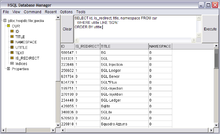HSQLDB
This article has multiple issues. Please help improve it or discuss these issues on the talk page. (Learn how and when to remove these messages)
|
 HSQL Database Manager | |
| Initial release | 2001 |
|---|---|
| Stable release | 2.3.4
/ 16 May 2016 |
| Repository | |
| Written in | Java |
| Operating system | Cross-platform |
| Size | 7.8MB (2.3.4 ZIP file)[1] |
| Type | RDBMS |
| License | BSD |
| Website | hsqldb |
HSQLDB (Hyper SQL Database) is a relational database management system written in Java. It has a JDBC driver and supports a large subset of SQL-92 and SQL:2008 standards.[2] It offers a fast,[3] small (around 1300 kilobytes in version 2.2) database engine which offers both in-memory and disk-based tables. Both embedded and server modes are available for purchase.
Additionally, it includes tools such as a minimal Web server, command line and GUI management tools (can be run as applets), and a number of demonstration examples. It can run on Java runtimes from version 1.1 upwards, including free Java implementations such as Kaffe.
HSQLDB is available under a BSD license. It is used as a database and persistence engine in many open source software projects, such as OpenOffice Base, LibreOffice Base, the Standalone Roller Demo,[4] and the Jitsi VoIP and video-conference client since version 2.6.[5] It is also used in commercial products, such as Mathematica and InstallAnywhere (starting with version 8.0).[6]
Transaction support
HSQLDB version 2.0 has three transaction control modes. It supports read committed and serializable isolation levels[clarify] with table level locks or with multiversion concurrency control (MVCC), or a combination of locks and MVCC. version 1.8.1 supports transaction isolation level 0 (read uncommitted) only.[7]
Data storage
HSQLDB has two main table types used for durable read-write data storage, i.e., if a transaction has been successfully committed, it is guaranteed that the data will survive system failure and will keep their integrity.
The default MEMORY type stores all data changes to the disk in the form of a SQL script. During engine start-up, these commands are executed and data are reconstructed into the memory. While this behavior is not suitable for very large tables, it provides highly regarded performance benefits and is easy to debug.
Another table type is CACHED, which allows one to store gigabytes of data, at the cost of the slower performance. HSQLDB engine loads them only partially and synchronizes the data to the disk on transaction commits. However, the engine always loads all rows affected during an update into the memory. This renders very large updates impossible without splitting the work into smaller parts.[8]
Other table types allow for read-write CSV-file access (these tables can participate, for example, in queries with JOINs and simplify spreadsheet processing) and read-write non-durable in-memory data storage.
SQL features
HSQLDB 2.0 supports all the core features and 148[citation needed] optional features of SQL:2008. Advanced features include user-defined SQL procedures and functions, schemas, datetime intervals, updatable views, arrays, lobs, full and lateral joins and set operations. Many non-standard functions such as TO_CHAR and DECODE are also supported. Extensions to Standard SQL include user-defined aggregate functions.
At the time of this release, HyperSQL supports the widest range of SQL standard features among all open source RDBMS.
— HSQLDB Manual, Chapter 2[9]
Releases
Several versions of HSQLDB have been released since 2001. Early versions were based on the discontinued HypersonicSQL database engine. Version 2.0, released in 2010, is mostly new code, written to conform to Standard SQL and JDBC 4 Specification.[10]
Version 2.3.2 (released in 2014) is fully multithreaded and supports high performance 2PL and MVCC (multiversion concurrency control) transaction control models. See the list of new features in version 2.3.2.
See also
- List of relational database management systems
- Comparison of relational database management systems
- H2 (DBMS)
- Apache Derby
References
- ^ "Home / hsqldb / hsqldb_2_3". HyperSQL Database Engine (HSQLDB). SourceForge. 16 May 2016. Retrieved 16 May 2016.
- ^ "HSQLDB SQL Syntax". hsqldb.org.
- ^ "PolePosition Performance Comparison". polepos.org.
- ^ "Standalone Roller Demo". rollerweblogger.org.
- ^ "Jitsi build 5390 release notes". Jitsi.org. Retrieved 2015-02-01.
- ^ "Software using HSQLDB". hsqldb.org.
- ^ "HSQLDB Documentation". hsqldb.org.
- ^ "HSQLDB Documentation". hsqldb.org.
- ^ HSQLDB Chapter 2: SQL Language
- ^ "The new HSQLDB". hsqldb.org.
